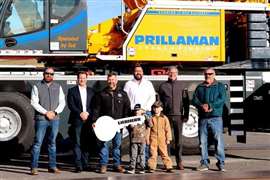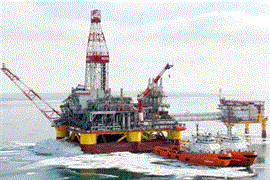Keeping busy
24 April 2008

Dirk Theunissen may have thought that after four very busy years setting up and expanding JLG's Maasmechelen production facility in Belgium he was due for a bit of a rest.
Not quite yet, it seems. JLG's 20-year agreement to produce Cat telehandlers in Europe and the US - announced in October - means that Mr Theunissen, who is operations director of the facility, finds himself planning the introduction of an entirely new product line at the facility and for what will no doubt prove to be a demanding client.
He is not daunted by the prospect, however, and says that a visit by a Caterpillar delegation in early December - the week before Access International's own appointment in Maasmechelen - had been an opportunity to reinforce the plant's credentials. These include the successful introduction of four separate new product lines between February 2002 and January 2003 and a further four new product introductions since then, most recently of the Liflux scissors.
The production scheme has already been established to accommodate the Cat handlers. All pre-delivery inspections (PDI) will now be done away from the plant, although still in Maasmechelen, and the current ES scissor line will be moved to the former PDI area during the Christmas-New Year break. 'We're already preparing the ES line now for the way it will be at the new location...the only thing that will change for the workers is that the restrooms will be a little further away”, he says.
The Cat B-series production line will be located alongside JLG's own telehandler line - which produces JLG-branded construction handlers and the small agricultural models made for Same Deutz-Fahr Group in Europe - and flexibility will be built in to allow production of both ranges on either line. (For example, the unique air-floating handling units, patented by JLG, that carry the handler chassis from one work station to another will be configured to take both JLG and Cat machines.)
JLG would not say what current production levels are at the facility, but reported that each line, working three shifts, could produce annually up to 3600 machines. The JLG aerial boom, telehandler and Liftlux production lines are currently working two shifts, and the ES scissors line is working a single shift, although that will rise to two from April.
Recruitment plans
Cat production will require the recruitment of 50 to 60 people. 'The intention is to have everything set up to begin production in March”, says Mr Theunissen. From March to September, Cat's B-series handlers will be produced at both Maasmechelen and Cat's facility in Leicester, UK, with the full production handover due to take place around next September.
A similar production planning process is now underway in the US, with the significant difference that, unlike in Europe, where JLG will build a largely unchanged Cat B-series of machines, it will develop a 'Cat-version' of JLG's US-design G series handlers for sale in the Americas.
Under the alliance - which JLG said could generate additional revenues of US$325-350 million annually from its financial year 2007 onwards - JLG will use Cat components such as engines, transmissions and hoses. JLG will also look at opportunities to exploit possible synergies for Cat components in its own machines.
Malcolm Early, JLG's marketing manager for Europe, says JLG will be responsible for developing future designs of the Cat handlers - although in close cooperation with Cat - and adds that, although the JLG and Cat handler lines will be differentiated, the two may well work together on plugging gaps in the respective product lines. '[In such cases] it might be a common product”, he says, 'but it would have to satisfy the needs of both Caterpillar and JLG.” It is too early, he says, to talk about a Roto type handler.
In the US, meanwhile, JLG designers are now working on a Cat-version of JLG's US G series handlers. This will be built alongside JLG's own G series and its Trak and Lull handlers. The Cat 'G' models will, again, use Cat components.
JLG will take on warranties of the Cat products when production ceases at Leicester, although Mr Early says the issue of who will actually supply parts is still being discussed.
For Cat, the big benefits of the deal are that it outsources its telehandler production to a company that has telehandler manufacturing facilities in both the US and Europe and has design experience in both European- and US-style machines.
The agreement is just one of a number of significant developments in the telehandler scene recently. Another may also be on the cards from Haulotte Group. The company's sales director, Segundo Fernandez, told Access International in December that Haulotte wanted a full line of handlers and that it would achieve this with or without its current Italian partner Faresin. He would not comment further on the future of the partnership.
Mr Fernandez added that Haulotte was investigating potential acquisitions, including in the US, with speculation that the key target is a telehandler manufacturer. He ruled out Dieci as a European candidate, saying the product was good but didn't have the brand recognition or dealer network that Haulotte seeks. This might suggest that Pettibone or Gehl could be targets, although a deal with Gehl would be complicated by its US production alliance with Manitou.
Haulotte's desire for a US product does not mean that European handlers cannot be sold in the US. JCB, for example, says its European-built handlers are suitable for both the US and European markets and have found acceptance in the US. It says the US is primarily a 'lift and place' telehandler market - with 95% of handlers sold with forks - and that it supplies for the US market traditional tool carrier models (for both forks and buckets) as well as three models sold strictly as fork versions.
Francoise Rausch, managing director of JCB Sales, says, 'Globally, JCB is going to invest in telehandlers. For us, its one of our key products.” Currently, JCB handlers are manufactured only in the UK, but Mrs Rausch says that if annual volumes in North America reached 1000 units then manufacturing [there] may be worthwhile. She would not say how close JCB was to that level or when it might be achieved. It seems reasonable to speculate that JCB is already looking at US telehandler manufacturing, even if the company will not confirm it.
Volvo Construction Equipment, on the other hand, has decided to exit the telehandler business altogether, and has sold the designs of its products - which were originally bought from UpRight - to US scissor manufacturer MEC.
Volvo's vice president for business development in Europe, Mr Faiz Ahmad, told AI that the telehandlers were primarily designed for the North American market and that its rental franchise network there would not offer sufficient volume to justify the development of the telehandler line. He said the issue was not with the design of these particular models and that Volvo would not be pursuing the manufacture of another line of telehandlers. 'We decided it does not fit in with our dealer network”, said Mr Ahmad.
The product inventory and tooling have now been transported from Volvo's North Carolina facility to MEC's plant in Selma, California, and the first two models - the 6000 lb (2724 kg) TH60 and 8000 lb (3632 kg) TH80 - will be ready for production before the summer of 2006. Both models, which will each have 42 ft (12.8 m) reaches, will be launched at the World of Concrete exhibition in Las Vegas in mid-January and also at the Rental Show in February.
Despite Mr Ahmad's comment about their being US products, Jim Tolle, MEC's sales director, told AI that the telehandlers will be suitable for both the European and North American markets. 'They look great, low and sleek - you'd swear they came out of Europe. The US market is used to simple, durable, heavy-duty machines... the Volvo machines combine European styling with a structure that the American market will appreciate.”
MEC acquired the telehandlers after asking its US aerial platform dealers what new products they wanted; ”We assumed they would want an [aerial platform] boom, but most said they wanted telehandlers in protected market areas, so our attentions were redirected.” Mr Tolle added that MEC's European dealers were also happy with the decision.
The telehandlers were acquired by Volvo from UpRight four years ago, and Mr Tolle said that Volvo had 'spent a lot of time and effort [on the machines] in the past four years” and had made some significant changes to the UpRight designs, including new hydraulic and electrical systems and a new cab. The handlers, which will use Deutz engines, have been converted into metric dimensions. Mr Tolle said several Volvo models had been on site being tested, some having over 2500 hours of jobsite time.
In addition to the 60 and 80 models, smaller TH40 and TH50 versions and a larger TH100 version - all three of which were designed but not built by Volvo - will be fully developed by MEC and launched in 2007, with the priority being given to the 10000 lb (4540 kg) model.
It isn't just JLG's Dirk Theunissen who is going to have a busy 2006.


